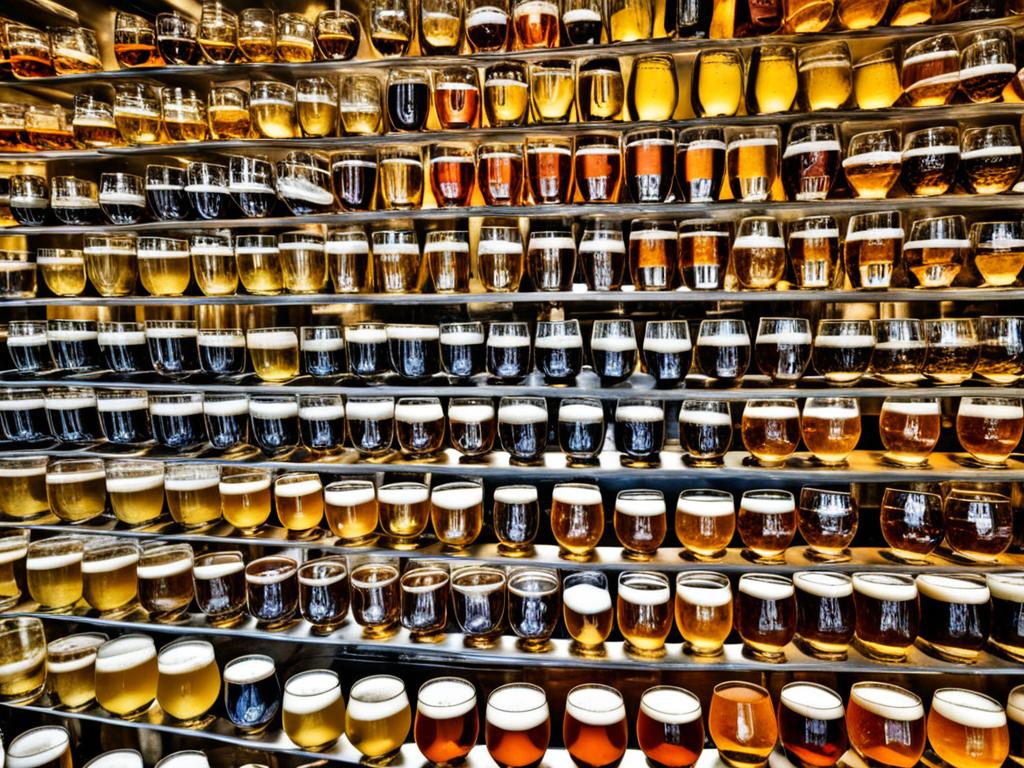Welcome to the wonderful world of beer! From hoppy pale ales to rich stouts, beer offers a wide array of flavors and styles that cater to every palate. In this article, we will take you on a journey to discover the different types of beer and the traditions that have shaped beer culture over the centuries. Whether you’re a beer aficionado or just starting your beer-tasting adventure, there’s something for everyone in this diverse and fascinating world.
Beer is not just a drink; it’s a reflection of history, culture, and craftsmanship. Each type of beer has its own unique characteristics, thanks to the variety of ingredients used and the brewing methods employed. Through the exploration of beer traditions, we will uncover the origins and stories behind popular beer styles, shedding light on the cultural significance that beer holds in different societies around the globe.
Join us as we delve into the brewing process, unraveling the art and science that goes into creating that perfect pint. From malted grains to hops and yeast, we will examine the ingredients that give beer its distinct flavor profiles. Gain a deeper understanding of the brewing process and appreciate the skill and passion that brewers bring to their craft.
Key Takeaways:
- Explore the fascinating world of beer, from different types to cherished traditions.
- Discover the art and science behind the brewing process.
- Learn about the craft beer revolution and the variety of styles it has introduced.
- Take a global tour of beer, exploring the unique flavors and cultural significance of various beer styles.
- Embark on a tasting adventure to further expand your beer knowledge.
Understanding the Basics: The Brewing Process
Welcome to the fascinating world of beer brewing! In this section, we will take a deep dive into the art and science behind creating this beloved beverage. Brewing beer is a delicate balance between artistry and scientific precision, where every step contributes to the final product.
The brewing process begins with carefully selected ingredients. High-quality malted grains, such as barley, provide the foundation for the beer. These grains are milled and mixed with hot water, which extracts starches and converts them into fermentable sugars. The resulting liquid, known as wort, serves as the basis for flavor and alcohol content.
The Fermentation Process: A Transformation
Once the wort is prepared, it undergoes fermentation. Yeast, the magical microorganism, is responsible for this crucial stage. It consumes the sugars in the wort and converts them into alcohol, carbon dioxide, and various flavor compounds. This process can take anywhere from a few days to several weeks, depending on the type of beer being brewed.
During the fermentation process, precise temperature control is essential to ensure the yeast performs optimally and produces the desired flavors and aromas. Brewers meticulously monitor and adjust the temperature to create a balanced and consistent product.
“The brewing process is a perfect blend of science and creativity. It’s a journey where knowledge and experimentation come together to create a wide range of unique beer styles.” – Alex Smith, Master Brewer at Craft Brewery Co.
From Conditioning to Packaging
After fermentation is complete, the beer undergoes conditioning. This stage allows the flavors to meld and mature, resulting in a smoother and more refined taste. Conditioning can occur in tanks or barrels, depending on the brewery’s practices.
Finally, it’s time to package the beer and get it ready for consumption. This can involve filtration, carbonation, and placing the beer into bottles, cans, or kegs. Each packaging method has its own advantages and affects the beer’s taste and shelf life.
The brewing process is an intricate dance between art and science, where creativity and precise measurements come together to create unique flavors and experiences. Whether you’re enjoying a crisp lager, a hoppy IPA, or a rich stout, take a moment to appreciate the labor of love that goes into each glass of beer.
| Key Steps in the Brewing Process | Summary |
|---|---|
| 1. Ingredient Selection | Choosing high-quality grains and other ingredients for brewing. |
| 2. Mashing | Mixing malted grains with hot water to extract fermentable sugars. |
| 3. Boiling | Boiling the wort with hops for bitterness and flavor. |
| 4. Fermentation | Adding yeast to the wort for the conversion of sugars into alcohol and carbon dioxide. |
| 5. Conditioning | Allowing the beer to mature and develop flavors through a period of rest. |
| 6. Packaging | Filtering, carbonating, and bottling or kegging the beer for consumption. |
Craft Beer Revolution: Innovations and Styles
The craft beer revolution has completely transformed the beer industry in recent years. This movement, driven by independent breweries and passionate brewers, has brought forth a wave of creativity and innovation that has redefined beer styles and elevated the craft beer experience.
With the craft beer revolution, brewers have embraced their artistic freedom, pushing the boundaries of traditional brewing techniques to create unique and exciting flavors. They have experimented with a wide range of ingredients, from fruits and spices to coffee and chocolate, resulting in beers that tantalize the taste buds and challenge conventional notions of what beer can be.
The craft beer scene offers an incredible variety of beer styles to suit every palate. Whether you prefer hop-forward IPAs, smooth and malty stouts, refreshing wheat beers, or sour ales with their funky flavors, there is a craft beer style that will satisfy your cravings.
But the craft beer revolution is not just about taste; it’s also about embracing the local and supporting small-scale breweries. Craft breweries are often deeply rooted in their communities, using locally sourced ingredients and contributing to the local economy.
“Craft beer embodies the spirit of innovation and community. It’s about bringing people together over a shared love for exceptional beer and supporting small businesses.”
So, what makes craft beer styles different from their mass-produced counterparts? Craft brewers take great pride in their attention to detail, quality ingredients, and hands-on brewing processes. They prioritize flavor and craftsmanship over mass production, resulting in beers that are meticulously crafted and bursting with character.
Whether you’re an adventurous beer enthusiast or a curious newcomer to the craft beer world, exploring the wide range of styles and flavors that craft breweries offer can be a thrilling journey. So, raise your glass and join the craft beer revolution!
Popular Craft Beer Styles
Let’s take a closer look at some of the most popular craft beer styles that have emerged from the craft beer revolution:
| Beer Style | Description |
|---|---|
| India Pale Ale (IPA) | A hoppy ale known for its intense bitterness and citrusy, floral flavors. |
| Stout | A rich and dark beer with roasted malt flavors, often featuring notes of chocolate and coffee. |
| Wheat Beer | A light and refreshing beer brewed with a significant portion of wheat, often with fruity and spicy undertones. |
| Sour Ale | A tart and acidic beer with complex flavors ranging from fruity and funky to mouth-puckeringly sour. |
| Pale Ale | A hop-forward beer with a balance of malt sweetness and hop bitterness, offering a range of flavors from citrusy to piney. |
These are just a few examples of the diverse and exciting craft beer styles that you can explore. Each style has its own unique characteristics and flavor profiles, offering something for every beer lover.
The Global Beer Landscape: From Pilsners to Porters
Embark on a global beer journey and explore the fascinating beer landscape that spans continents and cultures. From the crisp and refreshing pilsners to the rich and robust porters, each beer style tells a unique story and reflects the local traditions and flavors of its origin.
Pilsners: Crisp and Classic
Let’s start our beer adventure with the ever-popular pilsner. Originally brewed in the Czech Republic, this lager style gained worldwide recognition for its clean and balanced flavor profile. Pilsners are characterized by their golden color, subtle hop bitterness, and a biscuity malt backbone.
Enjoy the refreshing taste of a cold pilsner on a hot summer day or pair it with grilled seafood for a satisfying combination. Some renowned pilsner brands include Pilsner Urquell, Stella Artois, and Budweiser Budvar.
Porters: A Dark and Flavorful Delight
Now, let’s dive into the world of porters, a beer style known for its rich and complex flavors. Originating in England, porters are dark beers with roasted malt character, often featuring notes of chocolate, coffee, and caramel.
The velvety texture and bittersweet taste of a porter make it a great choice for colder months or as a dessert pairing. Pair a chocolate porter with a decadent chocolate cake for an indulgent treat or savor the roasty flavors of a coffee porter alongside a hearty steak.
The Global Beer Landscape
The global beer landscape is a tapestry of diverse flavors and brewing traditions. Explore the distinct beer styles from different countries and regions to truly appreciate the artistry and craftsmanship behind each brew.
From the crisp, palate-cleansing pilsners of the Czech Republic to the robust and flavorful porters of England, each beer style has a story to tell and a taste to savor. Take a sip, embrace the global beer landscape, and discover the world one glass at a time.
Ready to explore more beer styles? In the next section, we will take you on a tasting adventure, exploring the characteristics and flavor profiles of different types of beer. Get ready to expand your beer knowledge and enhance your drinking experience.
Exploring Types of Beer: A Tasting Adventure
Now that you have a basic understanding of the brewing process and the wide range of beer styles available, it’s time to embark on a tasting adventure. Exploring different types of beer allows you to expand your palate and discover new flavors that suit your preferences. Whether you enjoy crisp and refreshing lagers, bold and flavorful ales, or unique and creative specialty beers, there’s a world of options waiting to be explored.
When it comes to choosing which types of beer to taste, consider starting with the classics. Sample a variety of lagers, such as pilsners, bocks, and Munich helles, known for their clean and refreshing profiles. These beers are often light to medium-bodied with a smooth finish, making them a perfect choice for those who are new to the world of beer.
If you prefer ales, there are numerous styles to experiment with. From the hop-forward India Pale Ales (IPAs) to the malty and caramel-rich Belgian dubbels and tripels, each ale style offers its own unique flavor profile and brewing traditions. Embrace the hoppy bitterness of an IPA or savor the fruity esters and spicy notes of a Belgian ale.
For those seeking an extraordinary tasting experience, specialty beers are where innovation shines. Craft breweries around the world push the boundaries of traditional brewing to create unique and experimental brews. Barrel-aged beers, sour ales, fruit-infused beers, and even pastry stouts are just a few examples of what you might encounter during your tasting adventure.
To enhance your beer tasting experience, consider pairing your chosen beers with complementary foods. The right food pairing can accentuate the flavors and aromas of the beer, creating a harmonious culinary experience. For example, a hoppy IPA can be paired with spicy foods to balance the heat, while a malty stout can be enjoyed alongside rich chocolate desserts for a decadent combination.
Remember, beer tasting is a personal journey, and everyone’s preferences may vary. Take the time to savor each sip, noting the aromas, flavors, and mouthfeel of each beer. Keep a notebook handy to jot down your impressions and recommendations for future reference.
“Beer is an adventure waiting to be explored. With each new type of beer you taste, you unlock its unique story and create your own tasting adventure.”
So go ahead, gather your friends or create a tasting flight for yourself, and embark on a beer-tasting adventure. Cheers to discovering new flavors and experiencing the diverse world of beer!
Conclusion
In conclusion, our journey into the world of beer has been an enlightening one. We’ve explored the intricate brewing process, where art meets science, and discovered the wide range of beer styles that exist. From lagers to ales, stouts to IPAs, the types of beer are as diverse as the craft beer revolution itself.
Speaking of which, the craft beer movement has transformed the beer landscape, bringing forth innovative brewing techniques and pushing the boundaries of traditional beer styles. This revolution has not only expanded the options available to beer enthusiasts but has also elevated the appreciation for beer as a multidimensional beverage. It’s an exciting time to be a part of the craft beer scene.
As we’ve traveled around the globe, we’ve marveled at the cultural significance that beer holds in different countries. From the iconic pilsners of Czech Republic to the rich, dark porters of England, each beer style tells a unique story woven with tradition and heritage. By understanding the global beer landscape, we gain a deeper appreciation for the flavors and variations that make each beer a distinct experience.
Whether you’re a seasoned beer connoisseur or just beginning your journey, embracing the basics and traditions of beer will enhance your enjoyment of this beloved beverage. So, expand your palate, try new styles, and raise a glass to the wonderful world of beer. Cheers!







